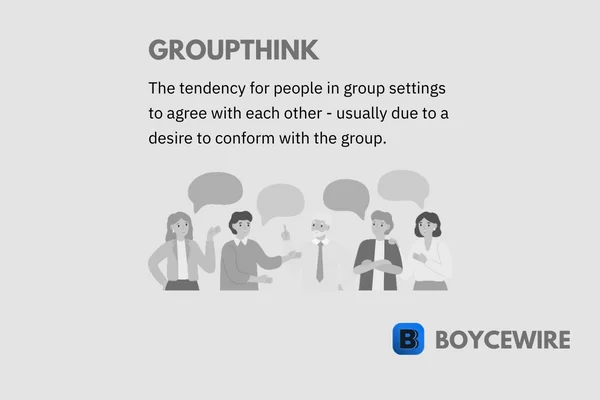Groupthink: Definition, Characteristics & Examples

What is Groupthink
Groupthink is the tendency for individuals to agree with each other in a group setting, usually in order to conform and keep harmony. This can contribute to inefficient decision making as ideas and thoughts go unchallenged in favour of cohesion. In other words, individuals in the group won’t disagree because they may fear social isolation.
Speaking out and being the only person in a group that disagrees (‘outgroup’) can have significant repercussions. For example, in sensitive subjects such as politics or religion, there is a need to conform in order to protect one’s career opportunities. The result is Groupthink, whereby viewpoints are not discussed or debated in fear of the repercussions.
Key Points
- Groupthink occurs when everyone agrees in order to keep the group harmony.
- One of the disadvantages of Groupthink is that there is no debate, so poor ideas are used.
- One famous example of Groupthink is that of the Bay of Pigs under JFK. Military advisers were too keen on pleasing the US president that JFK’s plans were never questioned – leading to military disaster.
For example, being in favor of homosexual marriage was seriously looked down upon a few decades ago. Declaring such may have cost you a promotion at best and your job at worst. However, the opposite is true now. Homophobic people are more likely to lose their job. So groups also tend to follow the pattern of contemporary beliefs and views.
What we find is that those in the ‘outgroup’ will conform in order to avoid such self-inflicted penalties.
We then have the inefficiencies that occur. Otherwise known as ‘yes men’, groupthink can lead to bad ideas passing through in order to maintain unity above all else. There is an inherent sense to ‘follow the crowd’ that is associated with the loss of individual creativity, uniqueness, and independent thinking. As a result, there is little innovation or creation of new ideas, and that by itself can impact a firm’s bottom line.
Characteristics of Groupthink
1. Invulnerability
The ‘ingroup’ tend to find an excessive sense of optimism and illusion of invulnerability. As everyone agrees on everything, there is an artificial increase in the feeling of self-worth and importance. So although the idea may be a bad one, nobody voices their reservations. In turn, the individual that has the idea tends to believe they have added value and have made an important contribution.
Now, this is not necessarily a bad thing from a psychological perspective. Everyone wants to feel important! However, when idea after idea is proposed and approved, it can create a feeling of ‘invulnerability’.
In turn, this can cause people to propose ideas without really considering them. Yet if groupthink persists, it can lead to worse and worse ideas coming through as standards drop due to complacency. When we think we are invulnerable, we tend to take greater risks and then pay the consequences.
2. Rationale
When a decision is agreed upon, that course of action is followed. However, those in the ‘ingroup’ may discover evidence, warnings, or other forms of negative feedback which would consider a rethink of the previous decision. As a result of groupthink, such evidence is ignored in favour of group harmony.
For example, a group of friends decides to go the Bob’s Bar for some drinks and food. Whilst on the way to the bar, one of the friends, Lucy, looks up reviews of the bar. Its food hygiene is bad and it has many negative reviews. However, she doesn’t tell the group, despite it being rational to do so. Perhaps in fear of being a ‘Debbie Downer’, or creating a feeling of animosity. Whilst it is rational to avoid a bad restaurant, the power of groupthink can overide such a thought process.

3. Morality
When the ‘ingroup’ follows each other, there is a tendency to value the group ahead of ethical or moral consequences. The need to conform can be stronger than any such belief.
For example, a lawyer may disagree about the ethical approach their firm is taking to a case. However, rather than voice their displeasure, they may partake in illegal or at least unethical behaviour. It may be seen as the best of two options, which is often the case with groupthink theory.
4. Distrust and Dislike of others outside the group
Those who do not conform can be treated unfairly by the ‘ingroup’. In a way, it’s a bit like school and the ‘ingroup’ are the popular ones. So for anyone on the outside, or who doesn’t conform, they are in for a rough time. In turn, it only helps to further cement the power of conformity within the group.
For example, the board of directors at a big firm are often victims of groupthink. They may accept the first idea in order to avoid confrontation and conform to the group. In turn, this helps to create a bond within the group.
There may be confrontations with shareholders or other stakeholders, but they are highly distrusted. Instead, they will stick to their own internal plans and ignore outside advice. After all, groupthink is driven by the desire to conform and the dopamine kick we receive when others like our ideas.
We tend to like people who agree with us and dislike those who don’t. When challenged by third parties, the group becomes defensive and can act like a pack of hyenas.
5. Pressure
In groupthink, there are many who are forced to conform by being pressured into an agreement. Think of a court case by which there is only one party who finds the defendant not guilty. It is clear in everyone else’s eyes and they want to deliver the verdict and not spend another week deliberating.
Often undue pressure will be put onto non-conformists or those in the ‘outgroup’. They will be shut down, interrupted, and unable to get their point across. This is so that the natural balance of the group is maintained.
6. Self-censorship
Those who suffer from groupthink tend to keep doubts about themselves under a form of self-censorship. Reservations and negatives are kept quiet in order to conform. At the same time, victims of groupthink tend to play down the importance of their doubts.
For instance, they may say ‘oh, it probably doesn’t matter’, or ‘it’s not important’. In part, this is a self-defense mechanism that is put in place to re-emphasize their position and need to be accepted within the group. In other words, the desire to conform and be accepted is greater than the desire to point out the pitfalls and mistakes of a decision.

7. Illusion of Unanimity
Those victims of groupthink tend to believe that there is unanimity among the group. In other words, everyone is in agreement – even though that is unlikely to be the case. However, this belief is confirmed by positive feedback provided by the group.
For instance, a team of work colleagues agrees to go out for a work lunch with each other. They aren’t very good friends but think all the others want to. Yet at the same time, none of them really want to go, but do because they think everyone else does!
Groupthink Examples
There are four well-known examples of Groupthink, which include the bay of pigs, the Challenger Space Shuttle disaster, Watergate, and the 1999 Major League Umpires Association. For example, Watergate occurred under President Nixon despite its obvious illegality. Even though the president had many intelligent advisors, none of them truly advised him against it.
Bay of Pigs Groupthink
In 1961, President John F Kennedy assisted Cuban exiles in launching an invasion to overthrown Cuban President Fidel Castro. It was a massive failure and led to a decline in relations between the US, Cuba, and the Soviet Union.
In fact, Groupthink theory originated as a result of the failed invasion. In 1973, Yale psychologist Irving Janis began examining the theory of groupthink. He concluded that the Bay of Pigs was a clear example as it showed President Kennedy had a vision of overthrowing Fidel Castro. However, his subordinates failed to challenge his plans, instead only acting in a way to facilitate them instead.
As JFK was only recently elected before the invasion, it was only understandable that his sub-ordinates were keen to impress. It is for that reason that groupthink occurred and resulted in one of the most dis-organized invasions in US history.
Challenger Space Shuttle Disaster Groupthink
In 1986, NASA launched a spacecraft that exploded within 73 seconds, killing all seven members on board. The issue occurred due to the fact that Thiokol warned NASA that the temperatures during take-off were too low. Critical components were not safe in such conditions and the take-off should be aborted.
These warnings were ignored by NASA and the launch took place anyway. This is a classic example of groupthink whereby external information is ignored in order to satisfy the ‘ingroup’.

Watergate Groupthink
In 1972, there was a failed break-in attempt on the Democratic National Committee headquarters at the Washington, D.C. Watergate Office Building. Phones were also hacked in order to obtain information on the Democrat nominee, George McGovern.
The scandal led to Nixon resigning as President, making him the first to do so. This was in order to prevent his impeachment and subsequent charges that would have resulted.
Those who took part in the scandal knew what they were doing was both illegal and wrong. However, groupthink played a massive part, largely driven by President Nixon. After all, many of his sub-ordinates were eager to impress and get in his good books, no matter the cost. People were willing to conform, no matter the cost.
1999 Major League Umpires Association Groupthink
In 1999, 57 Major League Baseball umpires resigned in order to force a new labor agreement to be reached. This was because they were unable to strike due to the existing agreement that was in place.
The idea was obviously a bad one as the American and National Leagues simply replaced them. In fact, many rescinded their resignations shortly after issuing them, which led to only 22 actually resigning from their post.
What seemed like a good idea as all the other umpires were doing it, turned out to be catastrophic. They took action without thinking about the logical consequences of their actions, driven by groupthink than rational thought.
How to Avoid Groupthink
1. Have people from different backgrounds
Diversity can prove beneficial in avoiding groupthink. People from different backgrounds will have different life experiences, beliefs, and views. In turn, this can lead to a more productive debate, as long as it’s kept peaceful.
Having a wide variety of backgrounds can not only introduce additional layers of perspective, but also a greater variety of ideas.
2. Encourage Debate
Debating is the main way to avoid groupthink. If the group can discuss the advantages and disadvantages of the idea, it can reduce the likelihood that a bad decision is made without prior consideration.
By debating the idea, it can be built upon to turn it from a bad idea into a good one. In turn, it can also create a stimulating environment by which further and better ideas may then arise.
3. Include members of other departments
By including members from outside of the group/department, we are able to get a different perspective. In the same way, diversity can help provide different viewpoints, so too can others from outside of the ‘bubble’.
For instance, government officials often make changes to the school curriculum. However, they are completely illogical to teachers. They are made from a government officials’ perspective and not from that of a teacher. The same can be said of in the workplace where processes are put in place that make no sense to those who have to implement it.
4. Take time over decisions
Often a group can rush into a decision, whether it’s impulsive or otherwise. In turn, this can lead to sub-optimal decision making and is one of the causes of groupthink. The victims often agree quickly to an idea and it is then implemented.
If we can take our time over decisions, it enables both the group and ourselves to properly analyze the situation and come to a more rational response. Sometimes decisions can be emotionally charged, so taking time can also help reduce the tension and a potential irrational decision driven by anger or rage.
5. Leaders to keep opinions to themselves
When in a group, it is very easy for sub-ordinates to follow the ‘leader’. Whether this is the manager or someone else. It is therefore important that the group puts forward ideas first, so as to avoid following the ideas of those in charge. In other words, managers and leaders may have an undue influence on the thoughts of their delegates.
We may see certain delegates agreeing with their superiors purely in order to further their career and stay in their ‘good books’. These are otherwise known as ‘yes men’, so it is important to try and avoid this occurring in the first place if possible.
6. Consult an outside expert
By consulting an outside expert, we are able to get knowledge and information that we may not have had otherwise. Victims of groupthink will often believe that they cannot be wrong due to the positive encouragement received within the group.
An outside expert will be able to challenge this, but it is important also to avoid bringing the consultant in the group as well. Therefore, it would be important for the expert to come to their own conclusion before voicing the group’s thoughts.
7. Ensure there is a ‘devil’s advocate’
Whether it’s a meeting, a social, or something else; it is important to have someone that is going to challenge the status quo. By ensuring there is a ‘devil’s advocate’, we can always ensure that we also consider the opposite point of view.
FAQs on Groupthink
Groupthink is the tendency for individuals to agree with each other in a group setting in order to conform and keep harmony. This can contribute to inefficient decision making as ideas and thoughts go unchallenged in favour of cohesion. In other words, individuals in the group won’t disagree because they may fear social isolation.
Some of the main causes of groupthink include:
1. Dictatorial leadership
2. Group Cohesion
3. Dislike of confrontation
4. Time constraints
5. Decisional Stress
Some examples of groupthink include:
1. The Bay of Pigs
2. Watergate
3. 1999 Major League Umpires Association Resignations
4. Challenger Space Shuttle Disaster
About Paul
Paul Boyce is an economics editor with over 10 years experience in the industry. Currently working as a consultant within the financial services sector, Paul is the CEO and chief editor of BoyceWire. He has written publications for FEE, the Mises Institute, and many others.

Further Reading
 Conflict Theory: Definition & Examples - Conflict theory refers to the state of constant conflict which is created by competition for limited resources. It was originally…
Conflict Theory: Definition & Examples - Conflict theory refers to the state of constant conflict which is created by competition for limited resources. It was originally…  Factors of Production: Definition, 4 Factors & Examples - The factors of production are all the various elements that are required to come together to create a good.
Factors of Production: Definition, 4 Factors & Examples - The factors of production are all the various elements that are required to come together to create a good.  Capital Flight: Definition, Causes, Effects & Examples - Capital flight occurs when investors or businesses remove their money from a country.
Capital Flight: Definition, Causes, Effects & Examples - Capital flight occurs when investors or businesses remove their money from a country. 